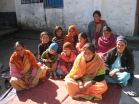(Press-News.org) BEER-SHEVA, Israel, March 10, 2014 - Ben-Gurion University of the Negev (BGU) researchers have unraveled the genetic basis of a hereditary disease that causes severe brain atrophy, mental retardation and epilepsy in Jews of Moroccan ancestry, according to a study published this week online in the Journal of Medical Genetics.
The disease, which the researchers have called PCCA2 (Progressive Cerebello-Cerebral Atrophy Type 2), is caused by two mutations in the VPS53 gene. It results in defective circulation of vacuoles (endosomes) within patents' cells and leads to detrimental excessive storage of "junk" within the cells.
Children who contract the disease are seemingly fine at birth and develop well until about six months of age. However, deterioration begins soon after with brain atrophy, severe retardation and epilepsy by age one.
One of every 37 Moroccan Jews carries one of the two mutations and based on the high carrier rate, PCCA2 is the most common severe genetic disease in Moroccan Jews discovered to date. Fifteen percent of Israel's total population (1 million people) is of Moroccan ancestry. Nearly 100,000 Moroccan Jews also live in the United States, largely in New York City, Washington D.C., Boston, and Florida.
In Israel, carrier testing and prenatal diagnosis of PCCA2 will enable eradication of this severe disease. Routine carrier testing in Moroccan Jews will likely begin within months. PCCA2 is a recessive disease: if both parents are carriers of a VPS53 mutation there is a 25 percent risk of the disease in each pregnancy.
The research team was led by Prof. Ohad Birk, head of the Genetics Institute at Soroka University Medical Center and the Morris Kahn Lab at the National Institute for Biotechnology in the Negev at BGU. The study was conducted by Miora Feinstein in Prof. Birk's lab as part of her doctoral thesis.The study was funded by the Israel Science Foundation and the Legacy Heritage Fund.
Prof. Ohad Birk's research has led to the discovery of more than 20 genetic diseases common in Arabs and in Sephardic Jews, providing insights into the nature of illness and unraveling molecular pathways of normal human development. In 2010, Prof. Birk's group discovered another gene for a similar disease, PCCA, which is also common in Jews of Moroccan and Iraqi descent.
Prof. Birk's translational approach has led to dozens of routine massive genetic carrier tests, prevention and practical eradication of numerous severe neurological disorders common in Arabs and in Sephardic/non-Ashkenazi Jews.
"There was an idea that Ashkenazi [of European descent] Jews have more disease than others, but when one begins looking at Sephardic Jewish diseases, they are there," Birk says. "They have just not been sorted out. Because they have not been sorted out, there was no carrier testing, no prevention programs or anything. I have shifted part of my lab into Jewish non-Ashkenazi—or Sephardic Jewish—diseases."
Ashkenazi Jewish diseases that now have carrier testing in the U.S. and Israel include Tay-Sachs disease, Canavan, Niemann-Pick, Gaucher, Familial Dysautonomia, Bloom Syndrome, Fanconi anemia, Cystic Fibrosis, and Mucolipidosis IV.
INFORMATION:
American Associates, Ben-Gurion University of the Negev
American Associates, Ben-Gurion University of the Negev (AABGU) plays a vital role in sustaining David Ben-Gurion's vision, creating a world-class institution of education and research in the Israeli desert, nurturing the Negev community and sharing the University's expertise locally and around the globe. With some 20,000 students on campuses in Beer-Sheva, Sede Boqer and Eilat in Israel's southern desert, BGU is a university with a conscience, where the highest academic standards are integrated with community involvement, committed to sustainable development of the Negev. AABGU is headquartered in Manhattan and has nine regional offices throughout the U.S. For more information, please visit http://www.aabgu.org.
Ben-Gurion U. researchers identify severe genetic disease prevalent in Moroccan Jews
2014-03-10
ELSE PRESS RELEASES FROM THIS DATE:
Penn researchers model a key breaking point involved in traumatic brain injury
2014-03-10
Even the mildest form of a traumatic brain injury, better known as a concussion, can deal permanent, irreparable damage. Now, an interdisciplinary team of researchers at the University of Pennsylvania is using mathematical modeling to better understand the mechanisms at play in this kind of injury, with an eye toward protecting the brain from its long-term consequences.
Their recent findings, published in the Biophysical Journal, shed new light on the mechanical properties of a critical brain protein and its role in the elasticity of axons, the long, tendril-like part ...
Predation on invertebrates by woodland salamanders increases carbon capture
2014-03-10
ARCATA, Calif.—Woodland salamanders perform a vital ecological service in American forests by helping to mitigate the impacts of global warming.
Global warming occurs when greenhouse gases like carbon dioxide are released into the atmosphere. Woodland salamanders facilitate the capture of this carbon before it is released by feeding on invertebrates (beetles, earthworms, snails, ants, etc.) that would otherwise release carbon through consumption of fallen leaves and other forest debris. Woodland salamanders are the most common vertebrate species in American forests; consequently, ...
Parkinson's disease: Quickly identifying patients at risk of dementia
2014-03-10
This news release is available in French. It may now be possible to identify the first-stage Parkinson's patients who will go on to develop dementia, according to a study conducted at the Institut universitaire de gériatrie de Montréal by Dr. Oury Monchi, PhD, and his postdoctoral student, Dr. Alexandru Hanganu, MD, PhD, both of whom are affiliated with Université de Montréal. These findings were published in the journal Brain.
Although Parkinson's disease is generally associated with motor problems such as trembling or rigidity, people with this disease actually ...
NASA satellites eye troublesome Tropical Cyclone Lusi
2014-03-10
Tropical Cyclone Lusi has spawned warnings and watches in the Solomon Islands, Vanuatu, and New Zealand as it moves through the South Pacific Ocean. NASA's Terra and Aqua satellites provided visible and infrared views of the storm that revealed it has become better organized.
NASA's Terra satellite captured a visible image of Tropical Cyclone Lusi over Vanuatu on March 9 at 23:30 UTC. The image showed towering thunderstorms surrounded the center and northwestern quadrants of the storm.
The next day at 02:17 UTC, NASA's Aqua satellite passed over Lusi and captured infrared ...
US cocaine use cut by half, while marijuana consumption jumps, study finds
2014-03-10
The use of cocaine dropped sharply across the United States from 2006 to 2010, while the amount of marijuana consumed increased significantly during the same period, according to a new report.
Studying illegal drug use nationally from 2000 to 2010, researchers found the amount of marijuana consumed by Americans increased by more than 30 percent from 2006 to 2010, while cocaine consumption fell by about half. Meanwhile, heroin use was fairly stable throughout the decade.
Methamphetamine consumption dramatically increased during the first half of the decade and then declined, ...
Scientists build thinnest-possible LEDs to be stronger, more energy efficient
2014-03-10
Most modern electronics, from flat-screen TVs and smartphones to wearable technologies and computer monitors, use tiny light-emitting diodes, or LEDs. These LEDs are based off of semiconductors that emit light with the movement of electrons. As devices get smaller and faster, there is more demand for such semiconductors that are tinier, stronger and more energy efficient.
University of Washington scientists have built the thinnest-known LED that can be used as a source of light energy in electronics. The LED is based off of two-dimensional, flexible semiconductors, making ...
A signal to spread: Wistar scientists identify potent driver of metastasis
2014-03-10
An international team of researchers led by scientists at The Wistar Institute have discovered and defined LIMD2, a protein that can drive metastasis, the process where tumors spread throughout the body.
Their study, published in the March issue of the journal Cancer Research, defines the structure of LIMD2 and correlates the protein in metastatic bladder, melanoma, breast, and thyroid tumors. Wistar scientists have also developed and patented a monoclonal antibody that may one day be used as a prognostic test to see if tumors have LIMD2, and plans are underway to create ...
Malnourished children are better fed when mothers have network of peers
2014-03-10
URBANA, Ill. – Women in rural India who participate in a vocational training program learn more than just life skills. A recent University of Illinois study found that mothers who participated in a program designed to educate and empower women gained a network of peers that led to increased bargaining strength in the home, and significantly improved their children's consumption of rice and dairy.
"Prior to participating in Mahila Samakhya, which loosely translates to women of equal value, most of the participants reported regularly communicating with fewer than five ...
New research shows elevated mercury from in-ground wastewater disposal
2014-03-10
As towns across Cape Cod struggle with problems stemming from septic systems, a recent study by a Woods Hole Oceanographic Institution (WHOI) scientist focuses on one specific toxic by-product: mercury. In a study of local groundwater, biogeochemist Carl Lamborg found microbial action on wastewater transforms it into more mobile, more toxic forms of the element.
His findings were published in Environmental Science and Technology in November 2013.
Mercury (Hg) is a toxic trace metal. Wastewater contains small amounts of it, but Lamborg found the chemical processes that ...
What's new in autism spectrum disorder? Harvard Review of Psychiatry presents research update
2014-03-10
Philadelphia, Pa. (March 10, 2014) – Recent years have seen exciting progress in key areas of research on autism spectrum disorders (ASD): from possible genetic causes, to effective treatments for common symptoms and clinical problems, to promoting success for young people with ASD entering college. Updates on these and other advances in ASD research are presented in the March special issue of Harvard Review of Psychiatry. The journal is published by Lippincott Williams & Wilkins, a part of Wolters Kluwer Health.
"Autism is one of the most challenging disorders to ...




